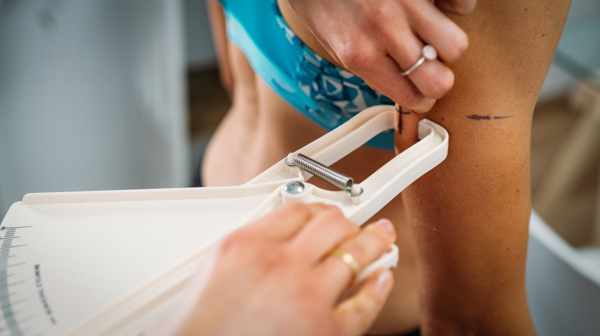
Second-year Kinesiology student Alyssa Gray is passionate about sports and fitness. She remembers being keenly interested watching events like the NHL draft combine, where hopeful NHL players are put through a series of tests to determine their fitness level and body composition.
Specifically, she remembers seeing athletes having their body fat measured by clipping a skinfold caliper at various parts of their bodies and being curious about the science behind it. So when she enrolled in the University of Guelph-Humber’s Fundamentals of Fitness Testing course, she was especially excited to explore this technique herself.
When classes shifted to a virtual environment, that hands-on experiential learning opportunity might have been in jeopardy. Instead, the Kinesiology program co-ordinated the delivery of an assessment kit called a KinKit – featuring a heart-rate monitor, stethoscope and skinfold caliper – to all the students taking the course, ensuring that students like Gray would have the equipment they needed to gain the practical skills they coveted.
“I couldn’t imagine how difficult this course would have been for us to learn, let alone for the professors to teach, if we did not have the KinKits available for us,” Gray said.
“I have seen the calipers used on athletes and have always wondered how it was possible to determine how much of our body mass was fat just by pinching the skin in various spots. After doing the procedure myself and seeing the calipers and equations, I can begin to piece together the logic behind the test and how it relates to our body mass.”
An introduction to fitness testing
Fundamentals of Fitness Testing, taught by Dr. Saro Farra, is intended to introduce Kinesiology students to different methods of assessing a person’s overall fitness in areas such as strength, cardio, flexibility, agility, speed and body composition. Those skills are then developed further over Kinesiology students’ final two years of study.
“Body composition is really important for both health-related fitness and performance-related fitness,” Dr. Farra said. “Some of the measures we take to assess body composition are easy to conduct, but others require a high level of technical skill.”
To instruct the students on those more technical measures – for instance, measuring heartrate by palpitation or using the aforementioned skinfold calipers – Dr. Farra asks the students to record themselves demonstrating these skills. He and his TAs then review the footage and provide feedback on how the students might improve their technique.
Although this is obviously not the ideal way to teach these methods, students are still finding the process rewarding.
“Being able to handle the equipment ourselves and learn to use the calipers correctly is definitely harder to do without having a professor or TA there in person to demonstrate and correct you. Despite that, it adds a challenge that actually can boost our learning; once we figure out how to use them correctly after guidance on Zoom, the students can truly say they have grasped the understanding of the process,” Gray said.
“The only way for us to succeed is if we truly learn how to do the skinfold tests. Although it poses a very large challenge, it does have rewards in the form of understanding and comprehension.”
Accommodating different learning styles
Even taking into account the considerable effort being focused on recreating the in-person learning experience to the greatest degree possible, some students are simply not as comfortable with online learning.
Those students appreciate the extra measures University of Guelph-Humber faculty are taking to ensure students aren’t falling behind.
“Throughout this semester, I’ve learned that I am definitely not a virtual learner,” said Safa Ahmed, who is also enrolled in Fundamentals of Fitness Testing. “Despite that, I really appreciate everything that my Kinesiology professors have been doing to compensate for the online transition — things such as applied worksheets, review lectures, live office hours, practice quizzes, and so much more.”
Gray, too, acknowledges that shifting to full-time online study has come with a steep learning curve. Still, she wants her instructors to know that the extra effort they have put in to help their students is not going unnoticed.
“Even though our generation is used to technology and being online with laptops and phones, taking University courses this way – especially Kinesiology – has presented new challenges,” she said.
“To the professors, teaching assistants, lab technicians, and any other staff who are working to make our learning of Kinesiology at the University of Guelph-Humber fair and appropriate – we appreciate everything that you do. I have to commend the professors, in my personal experience, who have put in the extra work to make sure students can succeed. Having various options like YouTube videos, voice-over lectures, live Zoom calls, PDF slides and more allows for nearly everyone to get what they need to learn.
“Nothing will ever match in-person learning, but given how hectic the world is today, putting in the extra time for the students does not go unappreciated.”







